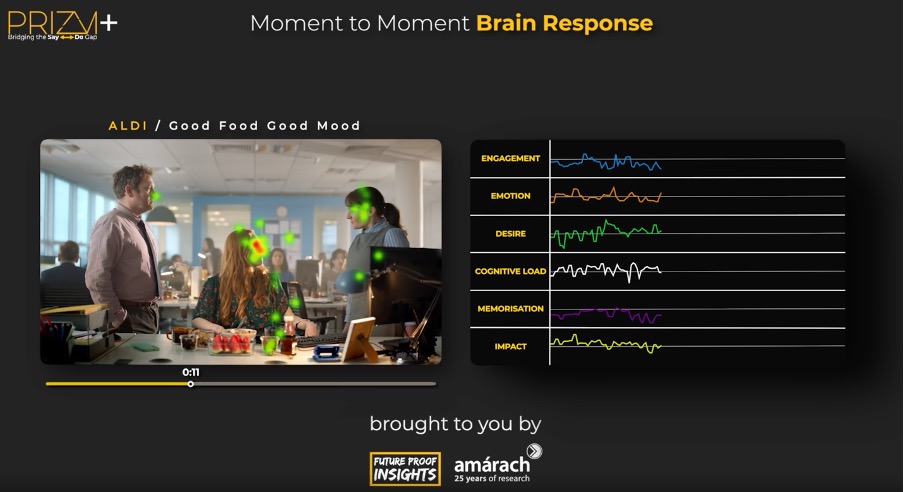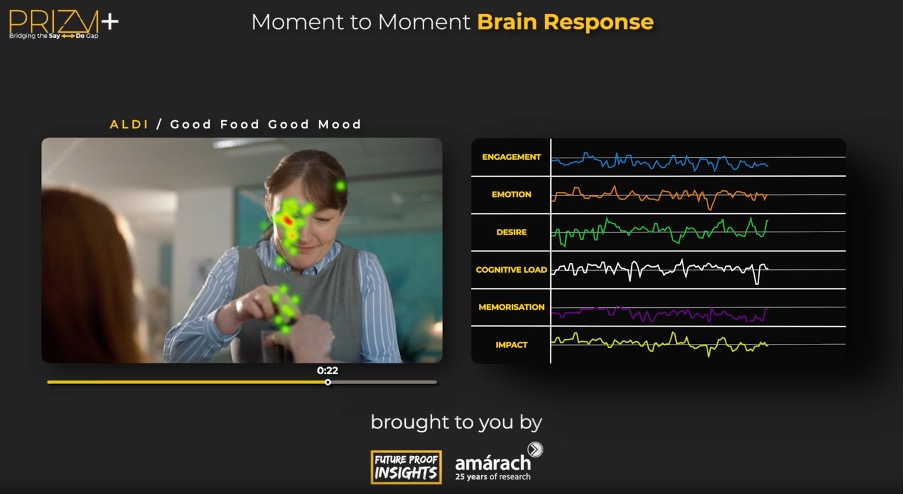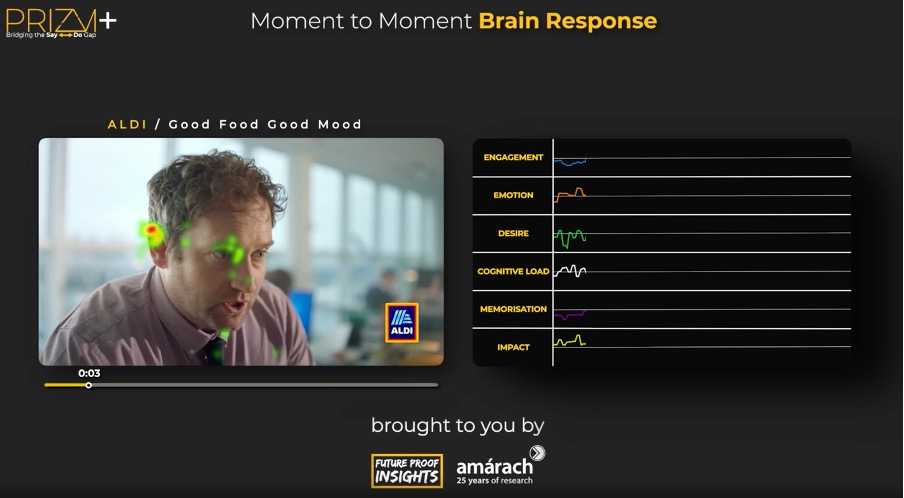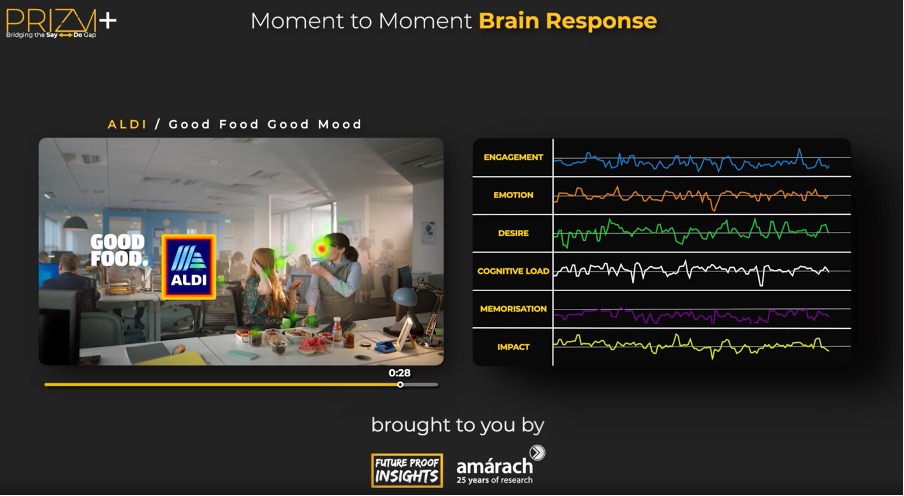Every week, Amárach and Future Proof Insights share exclusive findings from their PRIZM+ ad testing service, showcasing best practice creative advertising in Ireland.
Aldi’s “Good Food, Good Mood” campaign links quality food to everyday emotional uplift. In 30 seconds, it plays with tension and release: moments of workplace nerves dissolve into lightness when Aldi food is shared.
The tone is humorous, conversational, and rooted in recognisable scenarios, ensuring viewers see themselves in the interactions. The clever misdirection does more than entertain, it frames Aldi as the brand that flips problems into positives.
By showing food as the unexpected solution to tension, the concept positions Aldi as more than a retailer; it becomes associated with relief, lightness, and good humour in the consumer’s mind.
What makes this execution distinctive is its early misdirection. Most ads build tension slowly, holding back the reveal until the end. Aldi flips this by creating a small-scale drama upfront, only to undercut it with humour and food.
Our neural response data shows this approach is working: the brain rewards the audience when they realise their prediction error around the tension, with spikes in attention and memory. The result is that Aldi’s food is encoded as the source of emotional relief, not just another product shot.
The rhythm of the ad works. Engagement and Emotion lift when food is introduced as the solution, while Cognitive Load stays balanced throughout, showing that viewers can follow the story intuitively, without strain. Memorisation and Impact peak at the end-frame, where the “Good Food, Good Mood” line anchors the association.
Overall, Aldi lands its message: food is firstly framed as nourishment and secondly as a source of everyday uplift, embedding Aldi in the moments where moods shift for the better.
Best-Performing Scenes

Scene 3 (8s-18s) — “Breakfast as Defence”
Aoife faces down her boss Saoirse in what looks like a tense office showdown. Instead of folding under pressure, she casually offers blueberries: “Breakfast.”
Neural data shows Engagement and Emotion spiking here as the tension builds then collapses into humour. This tension heightens the viewer’s focus, when we anticipate conflict, the brain devotes extra resources to monitoring what happens next. That’s why the release feels so satisfying.
This is a textbook case of **prediction error, **the audience expects confrontation, but gets comedy and food instead. In neuroscience, prediction error is powerful because the brain remembers surprises more vividly than predictable outcomes. It’s the same technique filmmakers use when a scene suddenly flips expectation, making it more likely to stick in memory. Here, that mechanism makes the Aldi association stronger.
Another effect at play is processing fluency. The resolution is presented simply, one word and a handful of blueberries. Because it’s so easy to process, the brain can lock onto the joke and the brand cue without strain. This blend of surprise and simplicity explains why the moment scores highly and why it’s so effective at cementing Aldi in the viewer’s mind.

Scene 4 (19s-25s) — “The Mood Turns”
The office holds its breath as Saoirse softens and takes a berry with a smile. The pause builds anticipation, forcing the brain into a heightened state of attention. When the tension breaks with a subtle smile and the wordless acceptance of the food, Emotion and Impact both climb. Viewers vicariously share the relief, experiencing it almost as if it were their own.
Here, goal contagion and empathic mirroring are at play. In plain terms, when we see someone’s mood improve on screen, we can’t help but feel a bit of that lift ourselves. That shared emotional response makes the moment more memorable.
There’s also an element of conceptual closure, the story comes together neatly, the tension resolves, and the brain treats that as a complete, satisfying experience. For advertisers, this matters because moments like this don’t just land in the short term, they are far more likely to be remembered and recalled later.
Underperforming Scenes

Scene 2 (3s-7s) — “Email Whisper”
Aoife’s colleague nervously warns her about copying Saoirse on an email. The setup works narratively, but neural data shows only modest lifts. Emotion stays muted, there’s tension but no payoff yet.
This demonstrates a broader point: tension without enough cues (facial close-ups, sound design, exaggerated reactions) risks disengagement. For marketers, the learning is to give the brain more to work with during set-up, otherwise the audience may drift before the payoff arrives.

Scene 5 (26s-30s) — “End Card Drift”
The ad closes with the Aldi logo and line: “Good Food, Good Mood.” At the same time, the two characters continue talking in the background, and crucially they remain in focus on screen.
While Impact and Memorisation peak, the time series shows attention slipping because eye tracking reveals that viewers’ gaze is pulled toward the characters’ faces and their ongoing interaction.
As social creatures, we are naturally drawn to people over static logos or text, meaning the human conversation competes with and dilutes the brand cues. Conceptual closure is present, but the emotional punch is lighter than it could be because the closing shot is too busy.
For marketers, the lesson is clear: the end-frame is premium real estate, and anything that distracts from the brand will decay its impact. To maximise attention, close with a cleaner frame—logo and line supported by a decisive visual cue—rather than allowing secondary action to dominate.
Behavioural Impact (COM-B)
Motivation was the ad’s strongest driver. In practical terms, this means the ad left viewers not only entertained but also feeling moved to act on the message.
The humour and sense of relief gave an immediate, instinctive lift, while the relatable office scenario made the story feel personally relevant. Together, these elements ensured that the idea of Aldi as a mood‑shifter was not just noticed, but carried forward as something people felt compelled to remember and potentially act on.
Capability also performed well. In practice, this means viewers came away from the ad feeling confident that the behaviour it suggested, using Aldi to improve everyday moments, was realistic and achievable.
The ad made the idea of acting on the message feel straightforward, which lowers psychological barriers and increases the chance that the brand remains part of future decisions.
Opportunity was slightly weaker in general. Yet, the office micro-setting showed food being shared, but lacked wider social proof.
Interestingly though, for demographically, representative of potential office workers (25–44), Opportunity scored higher. For older audiences and those outside office life, resonance was lower.
Lessons for Marketers
- Use misdirection deliberately: Set up tension early and resolve it with your product. This taps into prediction error, creating stronger attention and memory encoding. Marketers can apply this by building a small drama or problem and then letting the product provide the unexpected solution.
- Make emotions visible on screen: Faces, reactions, and audible cues are powerful. They trigger empathic mirroring, which means audiences feel the same lift they see. Always ask: can the audience clearly see and hear the emotional shift?
- Keep the end-frame clean and decisive: Competing elements dilute attention. Marketers should strip back closing shots so the brand, logo, and message hold the spotlight. Consider softening background action to give brand cues maximum focus.
- Link product to feelings, not just features: Aldi’s win here is connecting food to mood. For other categories, ask: what is the emotional shift our product unlocks? Show that change clearly, so the memory sticks.
In short, Aldi shows that positioning food as the trigger for emotional transformation cements the brand in people’s minds as more than a supermarket. It becomes a reference point for how small, everyday actions can shift how we feel, giving Aldi an enduring role in moments that matter.
(Pic: Aldi Ireland/YouTube)









